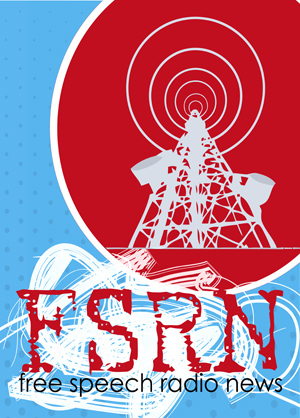Free Speech Radio News Going Silent After 17 Years of Movement Reporting

“I am 70 feet up in a red oak tree here in Bloomington, Indiana.” That was the opening of one of my first radio pieces for Free Speech Radio News back in 2001. The piece features an interview with a tree sitter who was using his body to block bulldozers from downing an ancient grove of trees. I went on to interview the tree sitter’s grandmother watching him from below and movement organizers about their history of protecting Indiana’s last remaining forests.
There is little radio I know of that sounds like this — radio that is so close to the movements that are building alternatives to the Death Star. Free Speech Radio News (FSRN) has been one of the few. It has allowed us, as organizers, to tell authentic stories featuring the voices and perspectives essential to building a future driven by love and equity rather than fear and domination.
On April 28, 2017, FSRN, which has struggled financially for many of years, will close its doors for good. FSRN will leave a distinguished legacy — 17 years of stories by thousands of reporters filing from every continent but Antarctica. Started in 2000 by freelance reporters on strike citing censorship by Pacific Network News, FSRN created a visionary model for distributed, international news production – one that was worker-owned and operated. During a time when corporate media was abandoning investigative journalism and closing local offices across the world, citing expenses, Free Speech Radio News found a grassroots way to grow both.
FSRN breaks stories because their sources are the first to know – and they go where the silences are, because their sources have trusted access to these voices. Listening to a thirty-minute FSRN broadcast feels like flying across the world, visiting movements resisting injustice. A brief look at recent reports turns up solid reporting on the Trump-du-jour, but also news that tends to be victim to “censorship by flooding,” where the multitude of media outlets are dousing us with the same sensational story, while other important news is ignored. For example Homeless Tours in Athens Greece, LA Legalizing Street Vendors to avoid deportations and Activists making 200-mile walk along route of proposed natural gas pipeline in North Carolina. These are stories of hope and resistance that we need to chart a new path forward.
In 2000, here in Urbana, Illinois, a group of us artists and organizers had just started our Independent Media Center in an old print shop in downtown Urbana, Illinois. Out of recycled wooden windows, we carved off a section of the floor space and cobbled together a production studio out of used and borrowed equipment. From there we began a weekly IMC Radio News broadcast, that grew into regular contributions for FSRN, as well as spots on Pacifica Network News, National Native News, Making Contact and others. Later, we acquired the downtown post office, built our own radio station, developed the first mesh-network wireless software, and launched dozens of careers in media, tech and organizing.
One of our Indymedia journalists, Sehvilla Mann, filed her first piece with FSRN when she was only 16 years old. She went on to get a masters degree in journalism and now serves as an investigative reporter on the city and education beat for WMUK public media in Michigan. She explains how FSRN was key to her life decision to go into journalism: “I was 24 or so and trying to decide if I wanted to pursue journalism full-time. I drove to Columbus, Ohio to report for FSRN on a law that was going to limit collective bargaining for public employees. I got to town and thought there would be crowds at the capitol, but there weren’t. Fortunately, I’d written down some phone numbers, so I made some calls and then I marched around downtown Columbus finding people and talking to them. I got home and filed on time. The thrill of shoe-leather! I thought, if I can do this, maybe I can be a full-time reporter. I owe a lot to FSRN.”
Sehvilla was one of many journalists who got their start at FSRN. Aaron Glantz, who was a founding producer of FSRN, is now a Peabody Award-winning senior reporter at the Center for Investigative Reporting. His work has sparked more than a dozen Congressional hearings, a raft of federal legislation and led to criminal probes by the Drug Enforcement Administration, the FBI and the Federal Trade Commission. When hearing of FSRN’s closure, he shared this: “17 years is a really long time for any non-profit journalism venture. I feel very blessed to have played a small role in this success — for all the careers that have started and the great work that everyone has done. We have made a difference!!”
I also caught up with Zoe Sullivan, FSRN reporter who now writes for the Guardian, Al Jazeera, and other outlets. She shared: “I’m grateful to have outlets like The Intercept, The Young Turks and The Real News Network, but losing FSRN, which aired primarily on community radio stations around the country, should be a reminder of how important independent media is along with those stations that broadcast it. Radio reaches people in a way that the Internet does not.”
As I reflect on that first piece I did for FSRN on the tree sitters, and talk to some of the hundreds of journalists who got their start with FSRN, I have to ask the question: How can we develop sustainable reporting representing diverse, grassroots perspectives that stay close to our movements? In this escalating crisis of information, when an election can be hacked using fake news, what will fill the void of FSRN?
Get Involved
If you'd like to help with maintaining or developing the website, contact us.
Publish
Publish your stories and upcoming events on Indybay.


